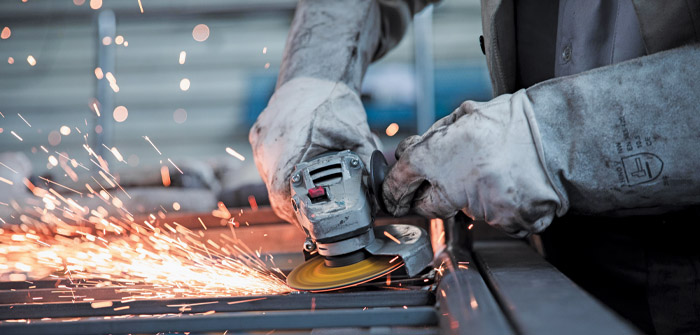(Photo | by Janno Nivergall)
The manufacturing industry in Central Oregon has a history of ups and downs. While Bend was founded as a goods-producing town due to our thriving lumber trade, in more recent decades we have allocated a higher percentage of our workforce to service-providing industries; reflected by the fact that since 1990, the manufacturing industry’s share of jobs in the Central Oregon workforce has decreased from 16 percent to seven percent.
However, this doesn’t mean that manufacturing isn’t thriving here in Central Oregon. While manufacturing has a lower share of the region’s workforce, the overall growth of the industry has consistently outpaced the national average for more than a decade.
In Central Oregon, the city of Redmond is the hub for the manufacturing industry. From 2010-2018, manufacturing jobs in Redmond increased by 81 percent, and this trend of fast growth seems to be continuing, according to Steve Curley, the REDI (Redmond Economic Development, Inc) Director for EDCO.
“In Redmond, we have continued to see growth with the manufacturing companies, which has precipitated needing more space for them to grow,” Curley said.
While the industry is growing, there are some current threats to that growth. The largest threat is one that is shared between most industries post-pandemic: hiring and retaining workers. Curley mentioned that, “There are simply not enough people to fill the jobs that are out there. Locally, our larger manufacturers are growing, and the biggest problem they face is the need for more people to keep doing well.”
Steve Bettis, the vice president of Medline ReNewal, said that it’s “no surprise” that the industry is facing a labor shortage, “Finding the right people and creating an environment that keeps employees can be a challenge, and that applies to all businesses, not just this industry,” he said.
Bettis continued, saying that he sees many companies focusing heavily on trying to provide competitive wages, practical benefits and a positive, flexible workforce culture that makes employees feel valued.
Erin Stone, CEO of i3D MFG, a 3-D direct metal laser sintering service that started in 2013 in Redmond, echoed the point that the post-pandemic industry has faced worker shortages, but also raised some reasons as to why workers in this industry tend to stay employed at the same company for longer than many other industries.
“We have pretty highly trained and specialized employees,” she said. “Highly trained and specific work helps retention.”
Stone explained that offering highly specialized work can benefit employers because it decreases the chance that the employee can jump ship and accept a better offer from a competitor. In Stone’s case, there are only about “10 or 15 other companies in the nation” that can do the work that i3D MFG does.
On the employee end, this specialized work often comes with a higher salary, and employers are more motivated to keep those employees happy because they understand that filling that position can be a time-consuming process.
For Stone, the recipe to retain workers is simple. Along with offering fair wages for specialized work, Stone said, “We celebrate them, we give out awards and we respect them as professionals. We let them know how much we appreciate them, and we try to be flexible with them to accommodate their lives and schedules.”
Stone added that it helps to have employees who work in specialized fields, saying that people don’t really end up there by accident, resulting in employees who have a passion for their work.
A trend that the industry is seeing that may have an effect on workforce needs in the future is the trend toward automation. Curley said that automation is the biggest trend the industry is seeing, and that, “automation is a necessary response to the lack of workforce and also a way to become more efficient in production.”
While automation in the industry is definitely increasing, Curley added that automation doesn’t necessarily decrease the number of available jobs, “The reality is that it doesn’t decrease many jobs, and the remaining jobs are higher paying because people have to keep that automation running,” he said. “This leads to higher paying jobs that come as a necessity to program, run and maintain the equipment.”
Bettis mentioned that automation has helped him focus on and retain a highly-trained team of employees that he calls his “core group.” He said that the vast majority of his workforce has longtime employment within the company, and show up for work every day. His goal with automation is to expand outward while keeping his core group happy, “keep those people and grow through automation,” he said.
While automation is a trend that cannot be ignored, it might not be the answer to the workforce shortage, as companies will always have to hire employees to keep the automation running smoothly.
In addition to automating their work, some companies are also focusing on education and streamlining the process of training employees.
At i3D MFG for example, CEO Stone puts a heavy emphasis on cultivating talent, instead of only finding it.
“When we first started, there were almost no trained people to talk to in the region,” she said. “We had to do tons of internal training.”
Over the years, Stone has prioritized internal training and promoting from within, both as a way to cultivate talent and to help retain it.
Stone said that, while the work her company offers is highly specialized, they can help anyone with some experience in welding or some sort of exposure to metalwork, so long as they want to learn.
“We can train well from within,” she said. “We offer tuition reimbursement for a variety of work-related courses, from welding to engineering courses. We encourage our employees to learn and grow in their personal lives and careers.”
Across the region, Curley notes that there are opportunities to learn these specific trades.
“COCC is working diligently through the Manufacturing and Applied Technology programs to develop a ready workforce in the trades,” he said. “Redmond High School also has a great program, which also feeds into the COCC programs. East Cascades Works also has incumbent worker training programs, but limited federal dollars have reduced capacity for their programs.”
Despite labor shortages, the manufacturing industry in Central Oregon is poised for more growth in the future, according to Curley.
“We should continue to see growth in the advanced manufacturing industries in Central Oregon. The attraction of the outdoors and livability of the region will continue to attract people to the area. There are specific sectors like advanced manufacturing, aviation/aerospace, high technology, outdoor industry, and food products that will continue to lead in our region.”
While Stone agrees that the local industry will continue to grow, she also sees it growing towards a certain future.
“We’re gonna see more automation, more acquisition and more merging of companies who do different things to consolidate their services,” she said. With gas prices as high as they are, shipping is now very expensive, so we’ll likely see a trend towards one-stop-shop type facilities that offer varied services with fewer middlemen.”
Bettis also sees growth on the horizon, and predicts that worker availability will increase in 2024, stating that companies who value their workers, pay competitively and create positive work environments, “will have workers lining up at the door.”





